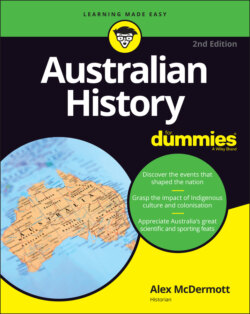Читать книгу Australian History For Dummies - Alex McDermott - Страница 41
Lost Dutch traders and wandering explorers
ОглавлениеMost of the trade, loot and riches that came from the New World of North and South America in the 1400s and 1500s were divided up between Portugal and Spain. However, in the 1600s a new heavyweight started muscling itself in on the global scene. This was Holland, which had managed to fight a successful war of independence against the Spanish.
In the 1600s, the Dutch began running successful trade operations of their own, setting up new trading stations and pioneering new navigation courses. One of the new routes ran right past the western coast of Australia — sometimes too close. The history of Dutch encounters with Australia can be summed up with a loud ‘bump’ noise, followed by a surprised ‘What was that?!’ and ending with ‘Oh — Australia’ (or rather, ‘New Holland’).
The Dutch dominated much of the shipping trade in and around Europe, distributing the spices and goods that Portugal was bringing in to their ports. The Spanish, well and truly miffed at the Dutch not wanting to be governed by Spain anymore, decided to cut them out of this trade at the start of the 1600s. The Dutch retaliated by smuggling in some secret Portuguese maps of the known world and setting off to establish a little trading supremacy of their own. At this they were spectacularly successful. They moved especially into the East Indies (modern-day Indonesia), setting up a trading company with an administrative centre in Batavia (modern-day Jakarta). The Dutch soon established a monopoly in the European trade of cloves, nutmegs, cinnamon and pepper, from which they made bucketloads of money.
Setting up an administrative centre in modern-day Jakarta created one problem for the Dutch: The time it took to sail from Europe to the East Indies was incredibly long. If you think 24 hours is a long time to put up with flying in a plane from Amsterdam to Jakarta, imagine multiplying it by 364. A round-trip in a 17th-century sailing ship took a year. Then, by accident, the Dutch discovered the roaring forties. This was a powerful circuit of winds that blew all the way round the world but further south than just about anyone had been. The Dutch found that after rounding the Cape of Africa they could continue south and then get a nice little ripping wind to blow them all the way along to Indonesia.
The only snag with this was that the Dutch had to know when to turn north again and sail up to the East Indies islands. Before a method of measuring longitude had been developed, knowing exactly how far along one had been blown was difficult. A lot of guesswork was involved. Mistakes were made. If the Dutch ships went too far they ended up running into the west coast of Australia before they made the port of Batavia. Sometimes, the Dutch ships ran aground and were even shipwrecked. Other times, they just ran alongside the Australian coastline, mapping it and looking out for signs of commodities for which to barter or that would make the place worthy of further investigation. Here, they drew a blank.
The comment of Dutch explorer Jan Carstensz sums up a whole series of disappointed Dutch traders and navigators with regards to what they thought of New Holland (modern-day Western Australia): It was ‘the most arid and barren region that could be found anywhere on the earth; the inhabitants too are the most wretched and poorest creatures that I have ever seen’. For traders wanting fancy things to take back to Europe, the ‘walking lightly on the earth’ style of Aboriginals appeared wretched and poor.
When he made his way up the east coast of Australia, British explorer James Cook had a different impression of Aboriginal life. He saw past the lack of tradeable material abundance in Aboriginal cultures and actually declared them the most contented — because most self-sufficient — of all peoples he’d encountered anywhere, including Europeans and Brits. But when Britain came calling in the late 18th century, Australia appealed to it for reasons other than trade (see Chapter 3).
